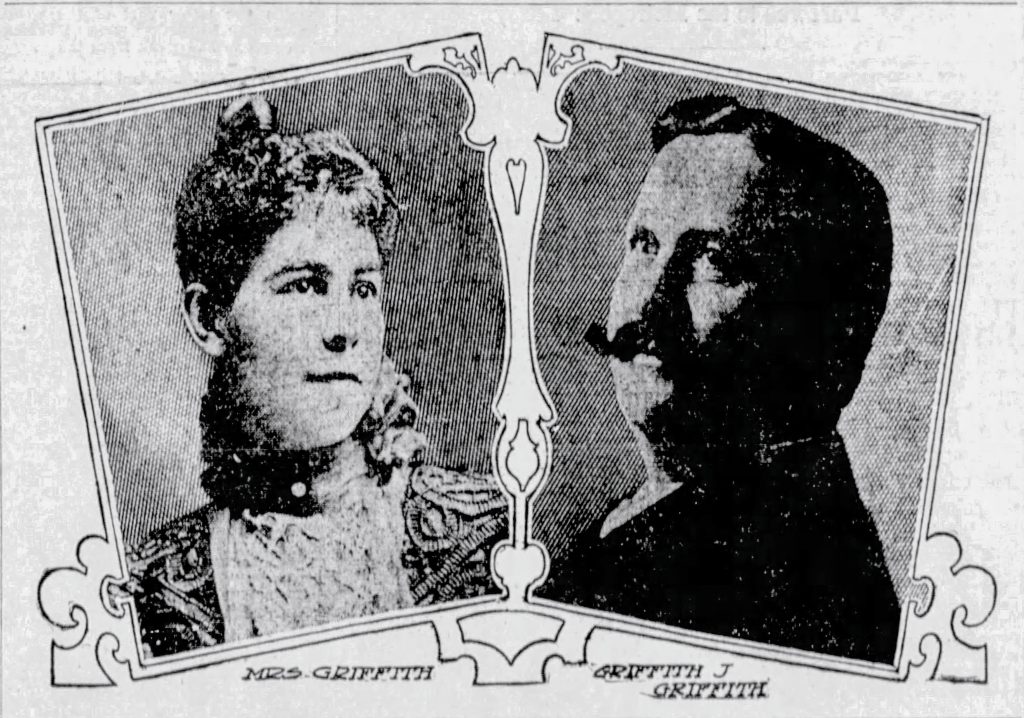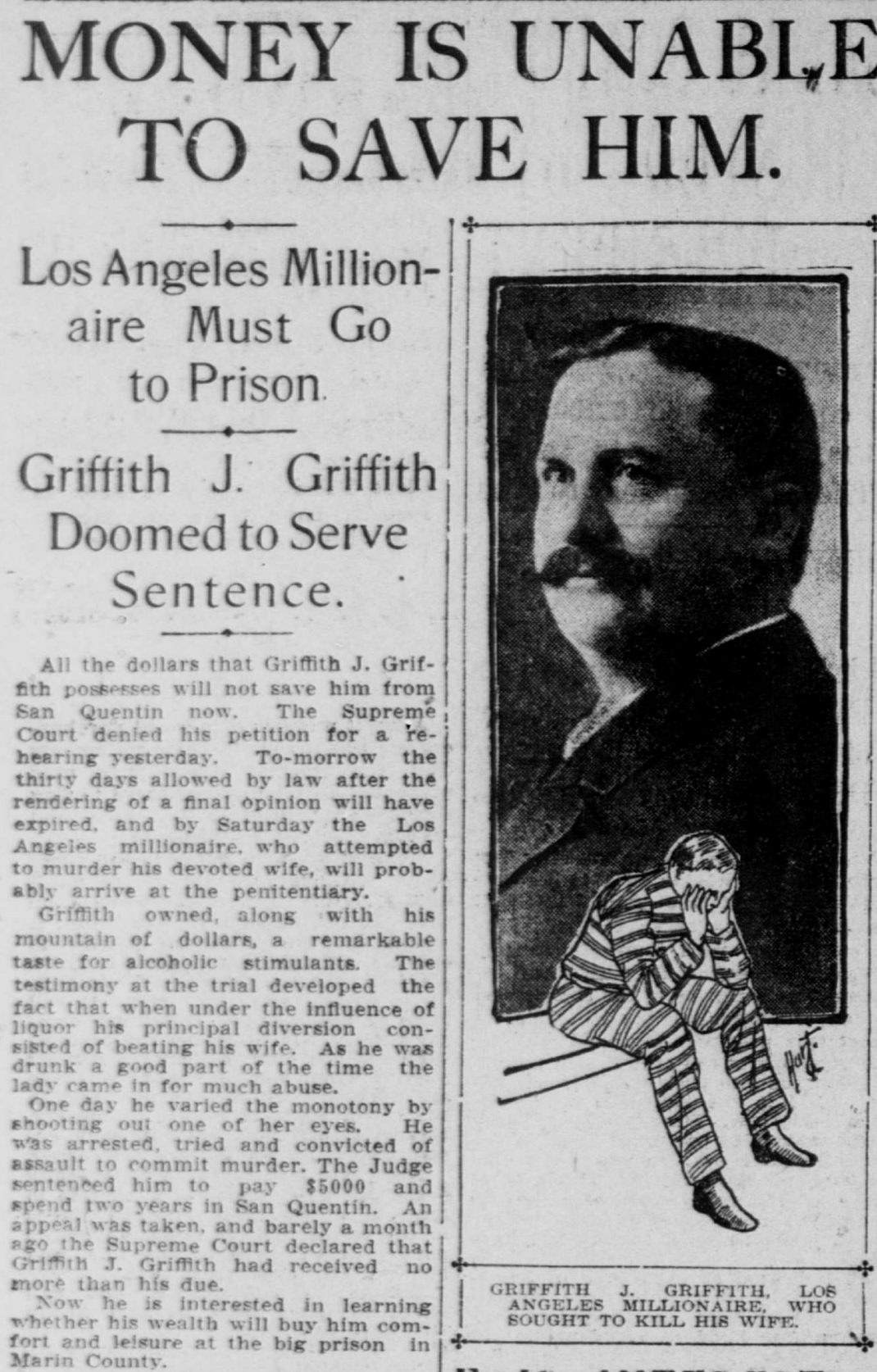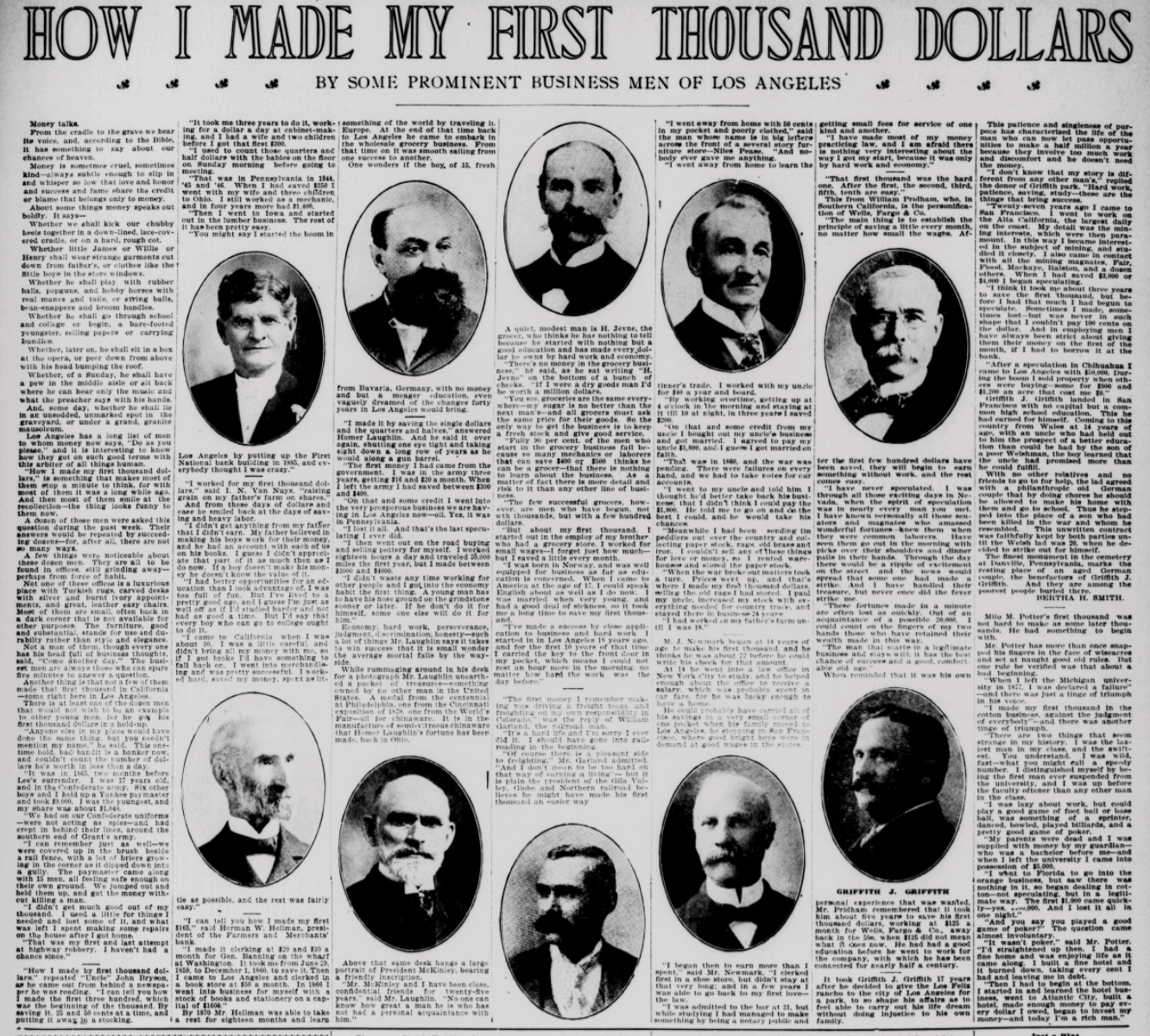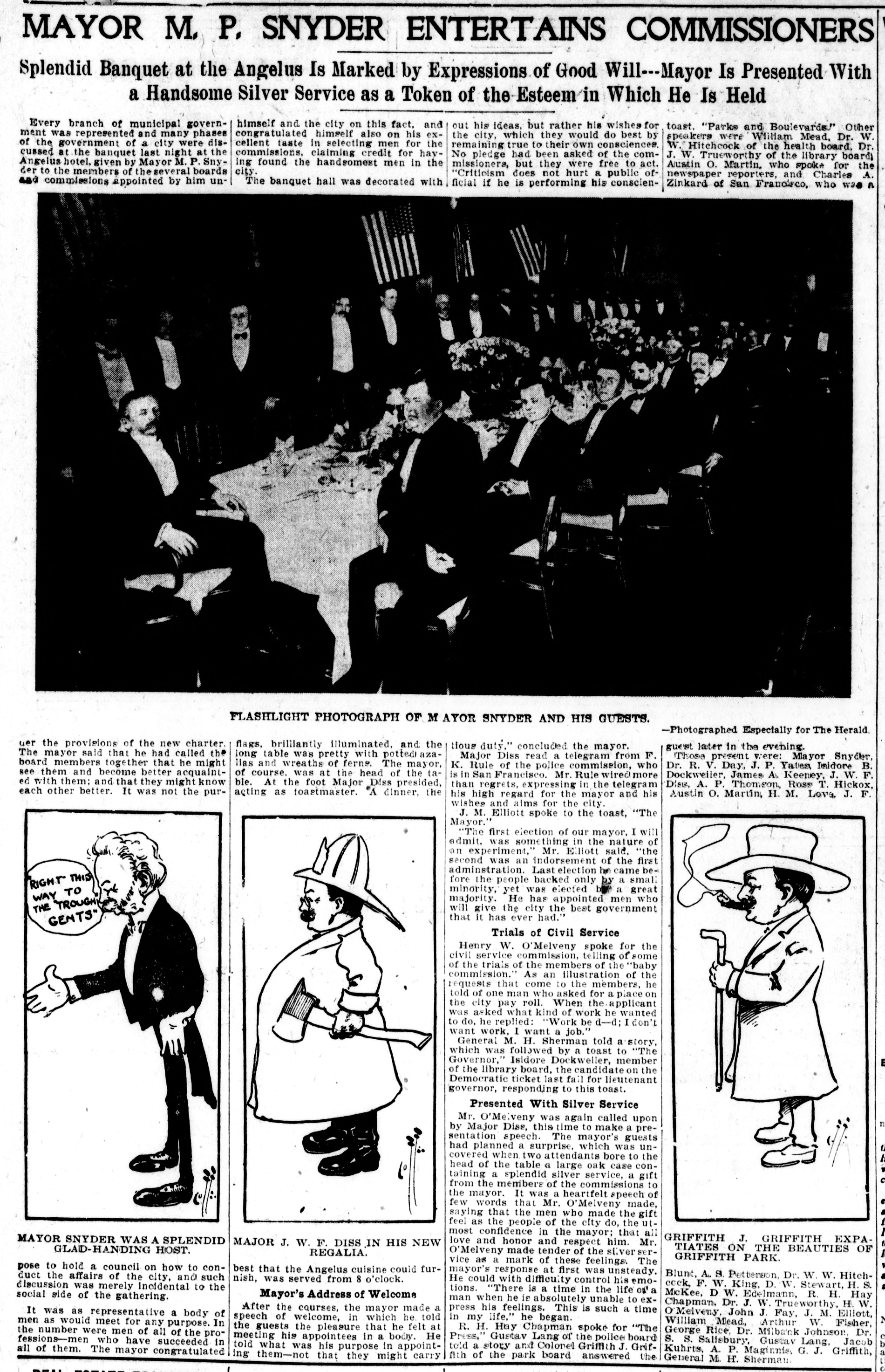14 The Making of a Maniac
“Maniac: someone who is or acts mentally unsound, especially a person who behaves in a wildly foolish, reckless, or dangerous manner.”
— Merriam Webster Dictionary
That image of a convicted, “plucked” Grif shuffling off to a jail cell — it’s hard to shake. What happened? What snapped? As far as friends and acquaintances could tell, Grif had it all by the late summer of 1903. In the seven years since donating Griffith Park, he had become a significant figure in Los Angeles business, politics and society. Running the Citizen’s League; helping local Republicans and organizing the city’s mourning for the assassinated President McKinley; lobbying for the improved San Pedro port; fundraising for the poor and Galveston hurricane victims; starting a Welsh social club. On the business side, he became known as “Mayor of Hollywood” for all his time and money invested there. And then the tile factory and its promise of a new industrial future for Los Angeles. He wasn’t beloved by all, but his rise and reach were respected.
The last year of the Griffith Gilded Age, 1903, was certainly his busiest. There were the little things like arbitrating a scuffle over whether to change the name of Hollywood’s Prospect Avenue to De Longpre Avenue in honor of the town’s most famous artist (Paul De Longpre, who did not get the tribute).[1] And his part interest in a new professional baseball team in Los Angeles.[2]
There were big developments, too. In February, he finally was made a park commissioner and finally had a bigger say in the development of Griffith Park. His plans for a hotel and incline railway serving Griffith Park were also progressing. Then, on August 1, he became an industrialist with the grand opening of the Pacific Art Tile factory in nearby Tropico.
So, when the Griffith family set off for Santa Monica and the beachfront Hotel Arcadia a few days later in August, it seemed like a well-deserved vacation. Instead, it would be Grif’s last few days living what, to outsiders at least, was the American Dream.
In hindsight, and after the court testimony — especially Tina’s — it is clear that Grif’s princely life was more complicated than it appeared on the surface. To be sure, Grif brought the tragedy upon himself, but it is also clear that stress points had built up over the years, mainly due to four factors: Grif’s hands in so many ventures; several personal setbacks; a wife determined to get her financial due; and Grif’s propensity for alcohol. Combined with his well-known ego, it was a recipe for manic behavior followed by one nearly deadly attack on September 3, 1903.
Clues that not all was well within the Griffith empire existed as early as the 1880s and were publicly available if one was inclined to look for them. A San Francisco lawsuit in 1883 alleged that the mining company Grif had made his fortune with was a sham[3]; Grif was late to the 1887 land boom and unable to subdivide and sell 1,800 Los Feliz acres for the next 10 years; in 1889 he even placed an advertisement to sell his entire 4,000 Los Feliz acres — probably fed up with the failing ostrich farm and railway.
Perhaps most importantly — and what the public, let alone acquaintances, would not have known — was that behind the façade of Grif’s storybook wedding in 1887 was a battle over Tina’s property inheritance. To acquaintances, the first few years of the Griffith marriage seemed like that storybook — trips to Europe and Mexico, summers on nearby Catalina Island, formal dinners at the Jonathan Club, evenings at the theater and opera downtown. The truth about the property battle would only come out during the trial and it became the crux of the prosecution’s argument that Grif was all about the money.
The 1890s saw even more stress points. A cloud was cast over Grif’s business reputation in 1890 when a lawsuit by his main Los Feliz tenant, who claimed Grif reneged on a property deal, went to trial. Grif won the lawsuit but nearly lost his life a year later when the tenant shot him in the back. In 1895, Grif sued the Ostrich Farm Railway for abandoning the line to Los Feliz — a sad ending to the once promising venture. In 1897, Grif’s personal secretary was arrested on charges he forged Grif’s name on checks. The trial went on nearly four years and again tarnished Grif’s image: his reputation as savvy businessman suffered when it was revealed that Grif had knowingly hired an ex-con as his assistant, and his philanthropic sincerity was questioned when the secretary alleged in court that Grif had only donated Griffith Park to reduce his taxes.
But all this was overshadowed by what seemed like the wildly successful, and wealthy, Grif of the 1890s. The man seen as so well off that he could afford to donate a vast property for the public good. The capitalist cashing in on the sale of the Briswalter estate. The dedicated citizen delving into politics and good government reform. The developer who helped build Hollywood by ensuring a rail line from Los Angeles and then to Santa Monica. And the industrialist lining up investors to join him in building the region’s biggest factory with the promise of hundreds of jobs.
Turn of the Century Tension
Was it all too much for Grif to juggle? The pressures and even the apparent successes — did they keep building until Grif, who probably all this time thought his wife was a thorn in his side, became the “Mr. Hyde” that his own lawyer observed? And then there’s the alcohol. Did Grif deal with pressure by drinking more? He wouldn’t be the first. As part of his insanity defense, he said that, yes, he had taken to drinking more over the years. He attributed it to his popularity as a speaker ever since he donated Griffith Park, but Tina was adamant it went far beyond drinking at speaking engagements. “Well, he never left the house without taking a drink,” she said at the preliminary hearing, “and he never came into the house without taking one, and, of course, I don’t know how many he took in between.”
The early 1900s saw Grif’s behavior become increasingly erratic and even violent. Tina herself established that. On the very first day of trial testimony, Tina’s lawyer began his line of questioning with this: “Had your husband threatened you anywhere before this time?” She replied that he first did so in the spring of 1900 at their suite in the Hotel Nadeau. Then again in 1902 and May 1903, just five months before the shooting.
Yet neither Tina’s nor Grif’s lawyers examined what pressures might have contributed to that worrying behavior. Tina’s team focused only on Grif desiring property and prestige, while Grif’s team detailed how alcohol drove him crazy.
What was happening in Grif’s world at the turn of the 20th Century? The public side looked impressive. By February 1900, he succeeded in rallying other Hollywood property owners to pay for an electric railway through Hollywood, thus creating a link from downtown Los Angeles all the way to Santa Monica. In March, he launched plans for the Pacific Art Tile company. In July, he was a delegate to the Republican National Convention, where he met presidential candidate Teddy Roosevelt. In September, he helped found a society for immigrants from Wales and organized local efforts to help victims of the deadly Galveston hurricane.
But he also was frustrated with the lack of progress at Griffith Park and the collapse of a plan for a national arboretum there. And personal matters weren’t flattering: He had just given relatives $20,000 and some land to end a lawsuit;[4] the embarrassing trial of Grif’s personal secretary dragged on; and Tina had new reason to worry about her financial future when her father died in August. While Grif had secured a slightly larger inheritance for her, he also forced her to accept a note delaying payment until 1906.
Moreover, a year or so before that first threat in the spring of 1900 is when Grif’s behavior became something scarier than a controlling husband, Tina testified. The drinking had gotten worse and Grif was now paranoid that Catholic actors were trying to poison him so that Tina, and the church, could get “his” wealth. “If soup was brought in individual dishes he would exchange plates with me,” Tina confirmed at the preliminary hearing, “I always took it. I humored him this way constantly.” At trial, and as part of Earl Rogers’ strategy to portray Grif as insane, Tina elaborated that “whenever he was drinking he accused me of infidelity … and of trying to poison him.”
So that’s the context leading up to early 1900 and the first threat, which was really a physical assault. An attack, by the way, confirmed by a Hotel Nadeau guest whom the Griffith’s son Van had rushed to for help.
“The colonel knocked a canary I had given the boy down from the window to the pavement below,” Sarah Cline recalled for the Herald on September 7, 1903. “Mrs. Griffith ventured a word of remonstrance and there was a terrible scene. The boy came running to me, saying his father was dragging his mother to the window by the hair and trying to throw her out. I ran for help and sent the porter to Mrs. Griffith’s assistance. I saw her husband brutally abusing her, and saw the porter compel him to desist. But when Mrs. Griffith afterward came to my room she said nothing of the affair, only when I said the canary was all right again, she said quietly, ‘You will never know what that little bird cost me tonight.’”
It should be noted that when Cline testified at trial the defense obtained a clarification that she never directly saw physical abuse but was describing what Van said to get her to go to the suite. Still, Cline knew the Griffiths well as she, too, lived at the Nadeau and had plenty to share with the Herald. “It is a wonder to me that she (Tina) has stood for all these years the continual abuse I know has been her lot,” she stated. “I cannot, as a loyal friend, see her reputation assailed without coming to her defense. She is one of the loveliest characters I have ever known and I will say of Colonel Griffith that he was gentlemanly, but at the bottom of the trouble is drink. When he was intoxicated he was a perfect fiend.”
“Why that woman is a saint,” she added of Tina. “She has endured everything, abuse, blows, insults, without a murmur. And through it all, when her friends and relatives advised applying for a divorce, she steadily refused to hear of it. If only for her boy, she said, she would never be party to a scandal.”
Cline had taken a peak behind the Griffith family façade from her vantage point as a neighbor. But on that particular day it is worth pointing out the assault was not triggered by property or any alleged infidelity. Grif lashed out because Tina dared to venture “a word of remonstrance” when he knocked the canary out the window. It seemed that Grif — after several years of Tina demanding her inheritance, and Grif perceiving that as a nagging wife — was now at the point where the slightest criticism could set him off.
Over the next two years, Grif saw new prospects and praise, but also financial pressure, including from Tina. He was gaining political prominence, attending a Los Angeles reception for President McKinley and then, a few months later, was chosen to plan the city’s tribute when the president was killed by an anarchist. In 1902, Griffith Park was getting some traction — Grif took city councilmen and park commissioners to a park site where he envisioned a vast lake created by damming part of the Los Angeles River.[5] On July 4, with Grif in attendance, locals planted an American flag at the highest spot in the park and informally named it Griffith Peak in his honor. In August, the venture to build an incline railway to the peak was announced. In nearby Hollywood, Grif was feted by Los Angeles elite for his 50th birthday, dubbed “mayor” by the Times for his development efforts, and became a director of the new Hollywood Bank.[6] Over in Tropico, a groundbreaking ceremony for the promised Pacific Art Tile factory was touted as progress.
But his business ventures were also requiring lots of cash. The Hollywood subdivision project that started in November 1901 required Grif to invest $100,000 in the property syndicate, as well as put up $25,000 in capital for the associated bank. And Pacific Art Tile, which had launched two years earlier, had seen costly delays, especially in finding suitable clay deposits for the fabrication of tiles.
In 1902, Tina also had the nerve to again ask about her inheritance and a month later, again at the Nadeau, came the second threat. “He took a revolver out of his vest pocket,” Tina testified, “and said, ‘If I ever suspect you of being untrue to me I will use it.’”
The third threat, in May 1903, followed the earlier pattern. “He came into my room in a strange manner,” Tina said at trial. “He kept his revolver then under the mattress in the folding bed. He pulled down the bed, took out his revolver, and said to me, ‘I wish to speak with you, step into the next room.’ I tried to get out but he stood in the doorway and would not let me go. I got out through the parlor door and left home that evening.” This time, however, Tina was ready to demand that Grif change. “I went back the next morning with my husband’s sister, and he promised on the Bible in the presence of his sister that he would stop drinking. I told his sister that whenever he was drinking he accused me of infidelity … and of trying to poison him.”
Of note is that during the trial it was revealed that the questions Grif had read to Tina before shooting her were written on the back of a menu card for an April 1903 banquet at which Grif was the featured speaker on the topic of “Woman”. The banquet was for the wife of a Hollywood business associate and Grif duly made his remarks that “woman is an ornament to society. As a sweetheart she has few equals and no superiors… What, I ask with emotion, would the people of the earth be without woman?”[7]
Besides the inherent irony, Grif’s use of the banquet card suggests he might have been planning a final confrontation with Tina months before the actual shooting. Perhaps he had written the questions just before the May assault and would have shot Tina then had she not found a quick escape. If that were the case, he would have been stewing over the next few months, waiting for a new chance to confront her.
Too Much too Soon?
Remember now, this was in the middle of 1903, at the height of Grif’s Gilded Age. He was busier than ever, and he was trying to get his biggest venture ever, the tile factory, off the ground. So 1903 was possibly also Grif’s most stressful year ever. The factory delays meant Grif was plowing more money into this long-term investment, which meant less disposable cash and probably even more pressure from Tina to get her inheritance money.
Whether it was stress, or just how busy Grif was, he did step back from certain activities that year. The Fiesta “knight” was nowhere to be found in the voluminous newspaper copy during each annual Fiesta in the early 1900s. The Citizen’s League fizzled and yet, when a new good government campaign formed and had success in 1902, he was not part of it. And he wasn’t a visible part of the entourage welcoming now President Teddy Roosevelt in May 1903 — even though Grif had been mentioned as being “close to the throne” just a few months earlier.
Perhaps the tile factory was all consuming that year, and Tina was only getting more upset and asking more often about when she would get control of her Briswalter inheritance. Her lawyer drew that tension out during the trial, asking her when they last argued over the property. “About a month before” the shooting, she testified, in other words around the time of the Pacific Art Tile grand opening. Worth noting, too, given Grif’s paranoia towards the Catholic Church, is that the last argument was also around the time a new pope, Pius X, was being elected.
“I asked him when he would straighten up my affairs,” Tina continued. Gage, clarifying that thought, interjected: “You say you made a demand on your husband for a settlement of your property?”
“The property in question was willed to me and it was understood that as soon as the heirs were paid off I should have it,” she replied. “I asked for a settlement, but never got it.”
A month after the shooting, Grif himself acknowledged the property friction in comments to Tina’s stepmother. “He said they were having difficulty over the old Briswalter property and that they were both on their knees making vows to do differently,” Jennie Mesmer later testified at trial. Grif admitted holding a gun but said it was just to intimidate Tina and that it went off accidentally, Mesmer added.
Briswalter was certainly at the root of their differences, and it made for constant tension even over something as seemingly innocuous as the Griffith Family burial plot. Following his stepmother’s death in November 1902, Grif spent a small fortune for a prime location and tall spire at the new Hollywood Cemetery. The Herald, in a February 11, 1903, update on cemetery improvements, noted that “the granite shaft which is being erected in the family burial lot by Colonel G. J. Griffith has been raised and is now receiving its finishing touches. It is a magnificent shaft, forty feet in height, resting on a base ten feet square … It can be seen from all parts of the valley. In the vault underneath are the remains of the mother of Colonel Griffith.”[8]
Upset about the cost, some $200,000 in today’s dollars, and the fact that it was not a Catholic cemetery, Tina refused to visit. Her rejection weighed so much on Grif that the final written question he never got to before shooting Tina was to get her to stop nagging him about it. And right after the shooting, when the Arcadia’s owner rushed to help Tina, Grif for no reason volunteered that his wife had become a religious bigot and was refusing to visit the family burial plot.
Alcohol in the Mix
Of course, all this was happening within the context of a man often drunk, often paranoid and increasingly desperate that his wife might try to leave him and take a big part of “his” fortune. Tina’s chief lawyer went to that line of questioning, to which Tina replied: “A few hours before I was shot something was said,” she stated. “He had been drinking heavily. I said I would go up home if he stayed there in Santa Monica and continued to drink.”
Was that confrontation the last straw that led him to write down his questions, or perhaps pull them out of his coat pocket after having had them there for weeks, and then again threaten Tina with a gun? Tina was vowing to go back to their Los Angeles residence, but perhaps Grif sensed it was worse than that. Perhaps he could not bear the thought of what Tina had vowed in May: “I told him that, if he continued to drink, I certainly would leave him.” And that, in turn, would mean publicity, a financial settlement and a damaged ego.

All this begets the question: What if Tina had been subservient, never questioning what Grif had done with her Briswalter inheritance? Surely, Grif would have had a prominent legacy as the biggest philanthropist in one of the greatest cities of the world. But that’s not fair to Tina, is it? She deserved to have control of her inheritance. And she deserved as much credit as her husband for Griffith Park, after all it was the proceeds from selling off her inheritance that allowed Grif to feel financially secure enough to go through with the donation.
And what if Grif had not felt so much stress over the years? Reviewing those pressure points was not meant to excuse what happened, but to offer a possible explanation about how he could have snapped. How his Jekyll became Hyde. How his ego and those stresses led to his mania.
Perhaps Grif was trying to accumulate power and prestige faster than he could handle it and, more importantly, without the support of his wife/financial partner. The two certainly saw things differently: Tina saw a husband using her wealth and then losing his mind; Grif saw a wife nagging him for 14 years over how he handled their combined fortune, and how he drank champagne and whisky to relax.
Had Tina been a docile wife, never asking about her inheritance, it’s likely there would have been no shooting — just another domineering husband whose legacy would have been intact while his wife suffered in silence. Instead, thanks to a wife willing to go to trial and a judge ready to come down hard, Grif went from elite to accused to condemned — and soon to San Quentin.
- Herald, August 19, 1903. ↵
- Herald and Times, March 20, 1903. ↵
- San Francisco Chronicle, July 18, 1883. ↵
- Times and Herald, April 6, 1910; Herald, April 28, 1911. ↵
- Times, April 13, 1902. ↵
- Times, June 27 and August 31, 1902. ↵
- Times, April 24, 1903. ↵
- It's more likely the Herald was referring to Grif's stepmother since his mother never moved to Los Angeles. In any case, the cemetery, now called Hollywood Forever, has no record of Grif's mother or stepmother being buried there. ↵


